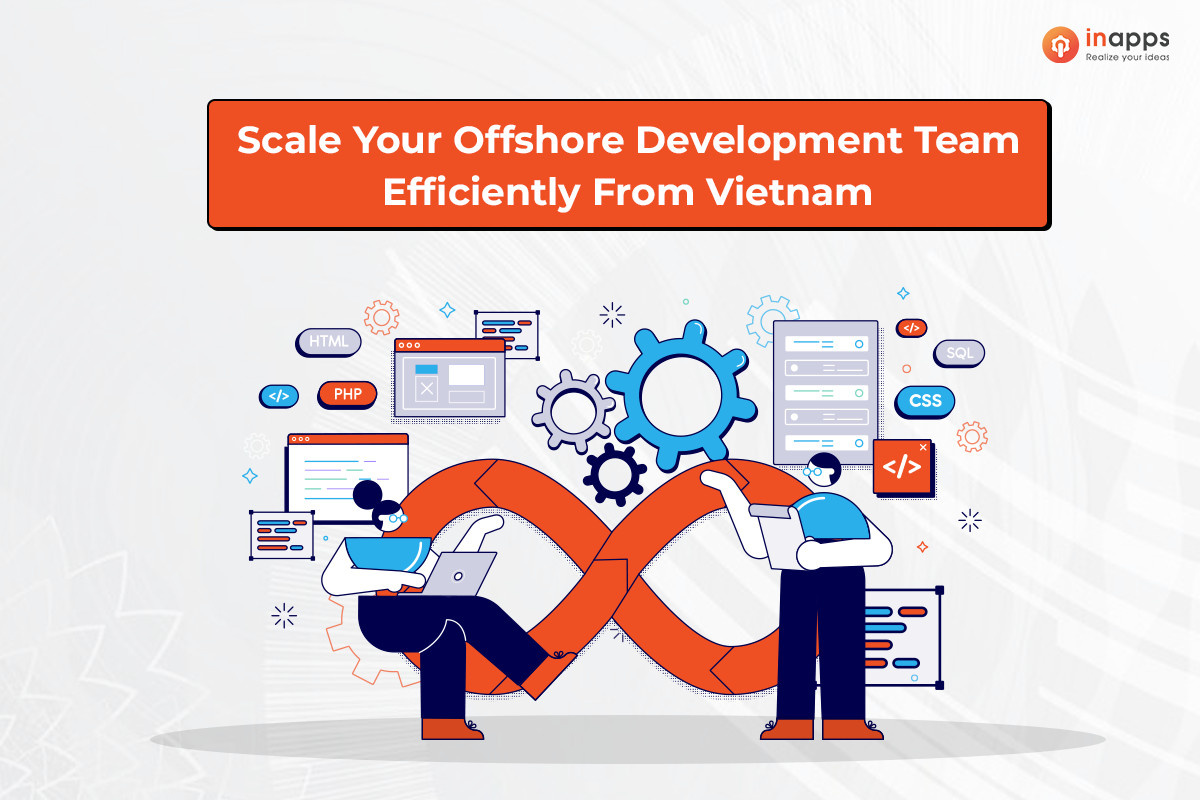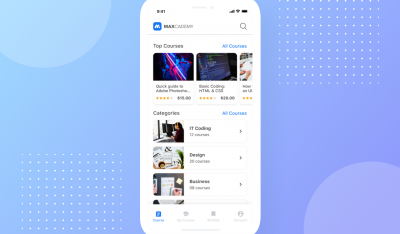- Home
- >
- Offshore News
- >
- Hire The Right Offshore Development Team In Vietnam

Revenue by outsourcing type. Statista reported. Apr 2024
There’s a reason behind the popularity of offshore software center. It’s that clients have skilled developers working at a fraction of the cost. This way, your app development can go live faster, and you get to save some money to spend on other core areas of your business. However, this model doesn’t come without risks.
In today’s blog, we’ll explain the ins and outs of hiring an offshore development team, so you can leverage this model to build your apps faster and minimize risks to your project.
1. What is an offshore development team?
An offshore development team is a group of software developers located in a different country than the company’s headquarters. These teams are typically hired to perform specific development tasks or projects. Development tasks can be feature development, maintenance and sport, etc while a whole project covers mobile app development, web app development, or any other custom app development.

What is an offshore development team?
Imagine you run a tech startup in the US and need to develop a new mobile app. Hiring developers locally might be too expensive and time-consuming. Instead, you hire an offshore team in Vietnam. This team works while your local team sleeps, making progress around the clock. The Vietnamese developers are skilled in mobile app development, and their work costs less than hiring locally. This way, you get your app developed faster and at a lower cost, while your local team focuses on planning and marketing the app.
In the real world, several outsourcing success examples come from big brands like Slack, Basecamp, WhatsApp, etc. One example is in 2009, WhatsApp co-founders Jan Koum and Brian Acton hired Russian developers to build the app with them.
2. In-house vs offshore development teams. Which to choose?

2.1 Pros and cons of hiring in-house development teams
In-house development teams are your employees who work directly for your company within your physical office. This traditional approach was and still is popular for a long time.
2.1.1 Benefits of in-house teams
Companies had direct control over their projects and easy communication. Teams working together in the same office could solve problems quickly. Also, in-house teams understand your business goals and align their work accordingly. This cultural alignment makes your team members feel a stronger sense of belonging.
2.1.2 Drawbacks of in-house teams
However, hiring and maintaining an in-house team can be very expensive. Salaries, benefits, office space, equipment, and other overhead costs add up quickly. In tech hubs like San Francisco or London, the cost of living and competition for talent drive higher salaries. For example, a senior developer in San Francisco might cost you over $150,000 annually, excluding benefits and other expenses.
A limited talent pool is another disadvantage of maintaining an in-house team. You are restricted to hiring talent within your geographical location, which might not always meet your specific needs. This makes finding a local developer with a unique skill set can be challenging and time-consuming.
Not to mention scaling your team up or down based on project demands can be difficult. Hiring new employees takes time, and if the project ends or slows down, you may face the challenge of having to let people go. For example, during a sudden increase in workload, finding and onboarding new developers quickly can strain your resources and delay your project.
2.2 Pros and cons of hiring offshore development teams
Offshore development teams are located in a different country and often work remotely. These teams are usually employed through outsourcing companies or agencies.
2.2.1 Benefits of hiring offshore development teams
About the benefits, working with offshore development teams shields you from the worries of in-house teams.
Firstly, offshore teams are often much cheaper due to lower living costs in their home countries. This allows you to access the same level of expertise at a fraction of the cost. For instance, a developer in Vietnam might cost significantly less than one in the US, so you can allocate your budget to other critical areas of your business.
Secondly, by looking beyond your local area, you can tap into a vast pool of skilled developers worldwide. This is particularly beneficial if you need expertise in specific technologies that are scarce locally. For example, if you need blockchain developers, you might find a talented team in Eastern Europe that fits your requirements perfectly.
Thirdly, offshore teams offer great flexibility in scaling up or down based on your project needs. This means you can quickly adjust your team size to meet changing demands without the long hiring processes associated with in-house teams. For instance, if you need to ramp up development for a major release, you can quickly add more developers to your offshore team to meet the deadline.
2.2.2. Cons of hiring offshore development teams
Please keep in mind that offshore development teams also come with unique challenges, including time zones, communication, and security risks. But you can minimize them by following our tips. It’s in section 2. Factors to consider before hiring offshore developers in the following blog.
Read more: Hire Offshore PHP Developers From Vietnam
3. How to hire an offshore development team from Vietnam?

How to hire an offshore development team from Vietnam
3.1 Identify your project requirements
Before you start looking for a team, clearly outline what you need from hiring an offshore development team. If it’s a complete app development project, then you should define the project’s scope, objectives, and requirements. This clarity will help you communicate effectively with potential development teams.
For example, if you run a small business and want to develop a new e-commerce website. Before contacting any offshore development team, you should outline the following:
- Scope: Develop a fully functional e-commerce website with a user-friendly interface.
- Objectives: Increase online sales, improve user experience, and integrate with existing inventory management systems.
- Requirements: Features needed include user registration, product catalog, shopping cart, secure payment gateway, and order tracking system.
Another important thing is to determine the technical skills your offshore development team members must have. For instance, if you need a mobile app, look for expertise in Flutter or React Native. Meanwhile, for a web application, JavaScript frameworks like ReactJS or Angular are crucial. If you know programming languages and how apps work, or you have someone in your in-house team who knows about this, then being upfront about necessary skills will save you a lot of time.
Read more: 12+ The Fastest Programming Languages List
However, for non-tech business owners, you can reach out to your offshore development center and consult them about the best technologies for your app development project. They’ll be more than welcome to help you.
3.2 Research Reputable Offshore Development Companies
Vietnam has a growing pool of talented developers. According to a 2023 report by TopDev, the country is home to approximately 530,000 IT professionals, with over 50,000 new graduates entering the workforce each year. Most of these IT programmers often work for outsourcing companies because these companies can provide them with stable employment. They’re also exposed to a variety of international projects.
However, there are a lot of outsourcing agencies out there, and finding the right offshore development center for your project can be tough. One way is to use platforms like Clutch and GoodFirms to find top-rated companies. These sites provide reviews and ratings from previous clients, so you’ll know how reliable and expert your potential partners can be.
Here’s an insider tip: Pay close attention to the consistency of positive reviews. If a company consistently receives great reviews, it’s likely a highly trusted offshore development center. Look beyond the star ratings and delve into the content of each review to understand what the company excels at, whether it’s technical expertise, communication, customer support, or proactiveness.

InApps Technology 5-star Review on Clutch
3.3 Evaluating Potential Offshore Development Teams
Once you’ve shortlisted 2-3 companies, the next step is to evaluate their offshore development team members thoroughly. One way to do this is by looking at their portfolios. Review past work if they’ve done any work that is similar to yours. For example, if you’re developing a fintech app, look at their past work on similar applications to gauge their expertise.
After this, you get to meet them and discuss with them via online interviews. Make sure to assess their technical skills, communication abilities, and cultural fit. How do you do this?
Firstly, for technical expertise, you can ask about their experience with technologies relevant to your project. For example, inquire about their proficiency with JavaScript frameworks if you need a web application. Secondly, you can assess their communication skills by seeing how clear and easy to understand they are. Lastly, this one is pretty optional, but you can determine if their work culture aligns with yours. This can affect the ease of collaboration and overall project success.
Key Questions You Can Ask:
- Can you provide examples of similar projects you’ve completed?
- How do you handle project changes or unexpected challenges?
- What is your approach to project management and deadlines?
3.4 Sign NDAs, GDPRs and payment requirements
An NDA is a legal contract that ensures the confidentiality of information shared between your business and the offshore development team.
What It Does:
- Protects Project Details: Keeps your project information private.
- Prevents Information Leaks: Ensures the offshore team does not share your confidential data.
- Provides Legal Security: Defines penalties for any breach of confidentiality.
In short, an NDA is crucial. It protects your intellectual property and ensures that the development process is secure and confidential.
Besides, there is GDPR. If the client is based in Europe, the offshore development center must ensure compliance with the General Data Protection Regulation (GDPR). GDPR is a regulation in the European Union that sets guidelines for the collection and processing of personal data of individuals within the EU. It involves including specific clauses in your contracts about data protection and privacy.
Finally, you and your offshore development team must agree on a clear budget and payment milestones. Define what constitutes a completed milestone to avoid misunderstandings. For example, set payments after the design phase, development phase, and final delivery.
3.5 Onboarding your offshore development teams
When bringing your offshore development team on board, it’s important to follow a structured approach. Here’s how to do it effectively:
Set Clear Communication Channels
First, establish how you and your team will communicate. Effective communication is key to any successful project. Decide on the tools you’ll use, like Slack for messaging and Zoom for video calls. Regular updates are essential to keep everyone aligned and on the same page. However, since you and the offshore teams are in different time zones, arranging daily meetings could be a problem. This leads to the next point.
Establish Time Zone Overlaps
Next, consider the time difference between your location and Vietnam. Scheduling meetings during overlapping working hours can facilitate real-time collaboration. For instance, if you’re based in the US, scheduling meetings in the morning works well because it corresponds to the evening in Vietnam. The other way around works too.
However, don’t overdo with meetings; otherwise, your teams will feel drained. Instead, quality meetings are better than quantity. Make sure everyone knows what to do, why they do that, and give them time to complete their tasks.
Provide Clear Documentation
You ought to share all necessary documents with your offshore team using project management tools, like Trello or Jira. This includes project guidelines, technical specifications, and design prototypes. For example, providing a detailed project brief can guide the team and reduce the need for constant clarifications.
Also, your offshore team must document their goals, actions, and progress clearly. This allows them to closely follow their plan and adjust accordingly if anything pops up. Their project manager (PM) can also follow up closely and address any potential issues promptly.
Integration with In-House Team
Finally, if you have an in-house team, then you should introduce offshore development teams to them. You can organize joint meetings for them to get to know each other first. Also, the meeting helps team members understand who is responsible for which tasks, so they can know who to contact for assistance or inquiries.
A kick-off meeting where both teams discuss the project goals and plan can set the stage for effective collaboration.
4. How to manage an offshore development team effectively

offshore development team management tips
4.1 Ensuring accountability
Ensuring accountability in a remote setting is difficult when you and your offshore development teams aren’t in the same physical environment. When there’s a deadline delay or technical issue, you could blame the wrong person, leading to decreased trust.
To prevent oversight, we used Jira to assign tasks with specific deadlines and detailed descriptions. Each task had an owner responsible for its completion. Weekly check-ins allowed us to discuss any roadblocks and provide support where needed. This approach ensured that everyone was accountable for their tasks and understood their contributions to the project’s success.
4.2 Quality Control
Quality can be an issue when working with offshore software development teams. However, with modern technologies and tools, you can manage quality from afar.
For version control and collaboration, you can use Github. It supports code reviews and issue tracking to maintain code quality. Use Selenium to automate testing for web applications across different browsers, so new changes don’t introduce bugs. Meanwhile, Jenkins automates building, testing, and deploying code. It helps catch issues early by validating each code change through automated processes.
In a past project, we used GitHub for version control and peer code reviews. Every piece of code was reviewed by at least one other developer before being merged into the main branch. Additionally, we used automated testing tools like Selenium and JUnit to run continuous integration tests. This approach significantly reduced bugs and ensured the code met our quality standards.
4.3 Data Security
With a project containing sensitive data, protecting the data when working with an offshore development team is a critical concern. You must only grant access to sensitive data to authorized personnel that has signed NDAs.
We used to work on a healthcare project that involved sensitive patient data. To protect it, we implemented role-based access controls to restrict data access. All data was encrypted both at rest and in transit. Additionally, we conducted quarterly security audits to ensure compliance with data protection regulations and address any security gaps
4.4 Building Team Cohesion
Building team cohesion isn’t about creating more and more virtual Zoom events where team members are too scared of opening up for fear of consequences. Here are some dos and don’ts to help you build a more connected offshore development team.
| Don’ts | Dos |
| Don’t Ask “How can I help you?”
This question can put pressure on the person and make them feel anxious. |
Ask specific and meaningful questions.
These questions help the employee share their thoughts and feelings honestly. For example:
|
| Don’t make social or team-building activities obligatory.
It makes those activities become a burden on your offshore development and in-house teams, rather than true happy hours. |
Ask your team members whether they like joining social/team-building events.
You can ask questions like:
|
| Micromanage and frequent check-ins.
This may be irresistible, but too many follow-ups don’t speed up the project, but slows it down. |
Set clear expectations from the start.
Be clear about tracking measures, so your offshore development teams know what they should be doing to make progress and share it with you and your teams. |
6. Hire offshore development team at InApps Technology

Why should you hire an offshore development team with InApps Technology? These are the highlights:
- Proven Success: Over 200+ successful projects, 60+ global clients, 98% customer satisfaction, and 70% customer retention.
- Cost-Effective: Competitive rates for middle-level developers starting at $1,900/month and senior-level at $3,300/month. Flexible models like ODC and Project-Based to fit budgets.
- Top Talent Pool: Access to 500+ top experts, offering dedicated teams that integrate seamlessly with your in-house team.
- Transparency and Customization: Tailored solutions with transparent cost and task management ensuring smooth collaboration.
How do you hire our development team? A simple breakdown.
- #Step 1: Identify Requirements: Define project scope and technical needs.
- #Step 2: Contact InApps: Reach out via web submissions, live chat or email: sales@inapps.net.
- #Step 3: Receive Proposal: Get a detailed proposal and quotation.
- #Step 4: Select Engagement Model: Choose from ODC, Project-Based, or Fixed Price models.
- #Step 5: Contract and Onboard: Finalize contract and onboard the team.
Partner with InApps Technology today!
Let’s create the next big thing together!
Coming together is a beginning. Keeping together is progress. Working together is success.




















